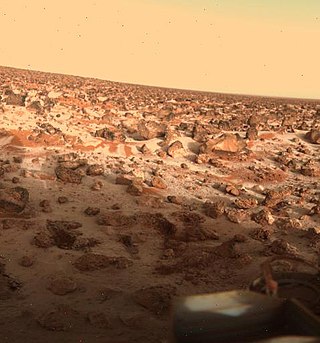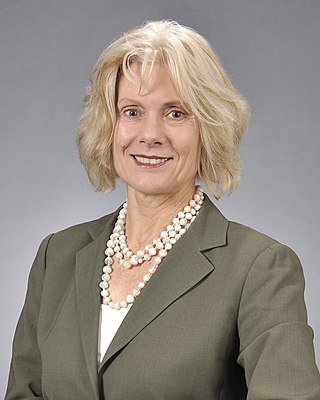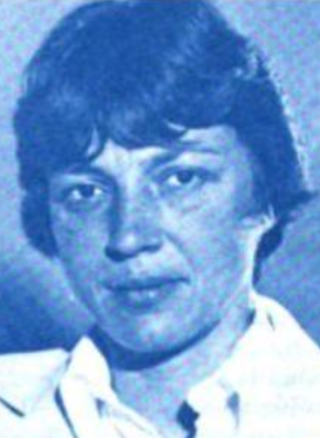
The mesosphere is the third layer of the atmosphere, directly above the stratosphere and directly below the thermosphere. In the mesosphere, temperature decreases as altitude increases. This characteristic is used to define limits: it begins at the top of the stratosphere, and ends at the mesopause, which is the coldest part of Earth's atmosphere, with temperatures below −143 °C. The exact upper and lower boundaries of the mesosphere vary with latitude and with season, but the lower boundary is usually located at altitudes from 47 to 51 km above sea level, and the upper boundary is usually from 85 to 100 km.

Utopia Planitia is a large plain within Utopia, the largest recognized impact basin on Mars and in the Solar System with an estimated diameter of 3,300 km (2,100 mi). It is the Martian region where the Viking 2 lander touched down and began exploring on September 3, 1976, and the Zhurong rover touched down on May 14, 2021, as a part of the Tianwen-1 mission. It is located at the antipode of Argyre Planitia, centered at 46.7°N 117.5°E. It is also in the Casius quadrangle, Amenthes quadrangle, and the Cebrenia quadrangle of Mars. The region is in the broader North Polar/Borealis Basin that covers most of the Northern Hemisphere of Mars.

MOPITT is an ongoing astronomical instrument aboard NASA's Terra satellite that measures global tropospheric carbon monoxide levels. It is part of NASA's Earth Observing System (EOS), and combined with the other payload remote sensors on the Terra satellite, the spacecraft monitors the Earth's environment and climate changes. Following its construction in Canada, MOPITT was launched into Earth's orbit in 1999 and utilizes gas correlation spectroscopy to measure the presence of different gases in the troposphere. The fundamental operations occur in its optical system composed of two optical tables holding the bulk of the apparatus. Results from the MOPITT enable scientists to better understand carbon monoxide's effects on a global scale, and various studies have been conducted based on MOPITT's measurements.

A Birkeland current is a set of electrical currents that flow along geomagnetic field lines connecting the Earth's magnetosphere to the Earth's high latitude ionosphere. In the Earth's magnetosphere, the currents are driven by the solar wind and interplanetary magnetic field (IMF) and by bulk motions of plasma through the magnetosphere. The strength of the Birkeland currents changes with activity in the magnetosphere. Small scale variations in the upward current sheets accelerate magnetospheric electrons which, when they reach the upper atmosphere, create the Auroras Borealis and Australis.

The ozone monitoring instrument (OMI) is a nadir-viewing visual and ultraviolet spectrometer aboard the NASA Aura spacecraft, which is part of the satellite constellation A-Train. In this group of satellites Aura flies in formation about 15 minutes behind Aqua satellite, both of which orbit the Earth in a polar Sun-synchronous pattern, and which provides nearly global coverage in one day. Aura satellite was launched on July 15, 2004, and OMI has collected data since August 9, 2004.

The polar wind or plasma fountain is a permanent outflow of plasma from the polar regions of Earth's magnetosphere. Conceptually similar to the solar wind, it is one of several mechanisms for the outflow of ionized particles. Ions accelerated by a polarization electric field known as an ambipolar electric field is believed to be the primary cause of polar wind. Similar processes operate on other planets.

Radio occultation (RO) is a remote sensing technique used for measuring the physical properties of a planetary atmosphere or ring system. Satellites carrying onboard GNSS-Radio occultation instruments include CHAMP, GRACE and GRACE-FO, MetOp and the recently launched COSMIC-2.

C/NOFS, or Communications/Navigation Outage Forecasting System was a USAF satellite developed by the Air Force Research Laboratory (AFRL) Space Vehicles Directorate to investigate and forecast scintillations in the Earth's ionosphere. It was launched by an Orbital Sciences Corporation Pegasus-XL launch vehicle at 17:02:48 UTC on 16 April 2008 and decayed on 28 November 2015.
Satya Prakash is an Indian plasma physicist and a former senior professor at the Physical Research Laboratory. He is known for his studies on Langmuir probes and other contributions in space and plasma sciences. A protégé of Vikram Sarabhai, Satya Prakash is an elected fellow of all the three major Indian science academies such as Indian Academy of Sciences, Indian National Science Academy and National Academy of Sciences, India as well as the Gujarat Science Academy and is a recipient of the Hari Om Ashram Prerit Senior Scientist Award. The Government of India honored him with Padma Shri, the fourth highest Indian civilian award for his contributions to the discipline of Physics, in 1982.

Matthew Graham George Thaddeus Taylor is a British astrophysicist employed by the European Space Agency. He is best known to the public for his involvement in the landing on Comet 67P/Churyumov–Gerasimenko by the Rosetta mission 's Philae lander, which was the first spacecraft to land on a comet nucleus. He is Project Scientist of the Rosetta mission.
Roger Jay Phillips was an American geophysicist, planetary scientist, and professor emeritus at the Washington University in St. Louis. His research interests included the geophysical structure of planets, and the use of radar and gravity to investigate the surfaces and interiors of the planets.

Anne Mee Thompson is an American scientist, who specializes in atmospheric chemistry and climate change. Her work focuses on how human activities have changed the chemistry of the atmosphere, climate forcing, and the Earth's oxidizing capacity. Thompson is an elected fellow of the American Meteorological Society, American Geophysical Union, and AAAS.
Richard Mansergh Thorne was an American physicist and a distinguished professor in the department of atmospheric and oceanic sciences at UCLA. He was known for his contributions to space plasma physics. He was a fellow of the American Geophysical Union.

Judith L. Lean is an Australian-American solar and climate scientist. She is a senior scientist at the United States Naval Research Laboratory. Lean is a three time recipient of the NASA Group Achievement Award and an elected member and fellow of several academic societies.
Anne Ritger Douglass is atmospheric physicist known for her research on chlorinated compounds and the ozone layer.
Mary Hudson (born January 6, 1949} is the Eleanor and Kelvin Smith Distinguished Professor of Physics at Dartmouth College. She is known for her research on the weather patterns that occur due to solar eruptions. She was elected a fellow of the American Geophysical Union in 1984.
Michelle F. Thomsen is space physicist known for her research on the magnetospheres of Earth, Jupiter, and Saturn.

James Wynne Dungey (1923–2015) was a British space scientist who was pivotal in establishing the field of space weather and made significant contributions to the fundamental understanding of plasma physics.

Dianne Kasnic Prinz was an American scientist, a physicist with the United States Naval Research Laboratory. She trained as an astronaut, and was mission communicator for STS-51-F.
Randall V. Martin is a scientist, engineer, academic and author. He is the Raymond R. Tucker Distinguished Professor in the Department of Energy, Environmental, and Chemical Engineering, with a courtesy appointment in Computer Science and Engineering at Washington University in St. Louis, McKelvey School of Engineering.













